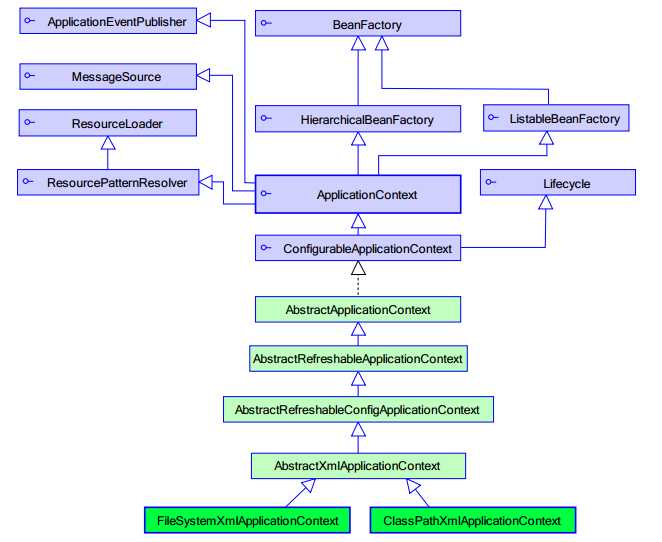标签:classpath 垃圾回收 web项目 url 数据类型 alt 注意 div set
Java源码是经典学习范例
Spring的源代码设计精妙、结构清晰、匠心独用,处处体现着大师对Java设计模式灵活运用以及对Java技术的高深造诣。它的源代码无意是Java技术的最佳实践的范例。
|
Spring基本包
|
spring-beans-4.2.4.RELEASE.jar
|
|
spring-context-4.2.4.RELEASE.jar
|
|
|
spring-core-4.2.4.RELEASE.jar
|
|
|
spring-expression-4.2.4.RELEASE.jar
|
|
|
log4j
|
com.springsource.org.apache.commons.logging-1.1.1.jar
|
|
com.springsource.org.apache.log4j-1.2.15.jar
|
<?xml version="1.0" encoding="UTF-8"?> <!-- 导入schema 约束的位置在: ..\spring-framework-4.2.4.RELEASE\docs\spring-framework-reference\html\xsd-configuration.html 文件中。 注意:要导入schema约束 --> <beans xmlns="http://www.springframework.org/schema/beans" xmlns:xsi="http://www.w3.org/2001/XMLSchema-instance" xsi:schemaLocation="http://www.springframework.org/schema/beans http://www.springframework.org/schema/beans/spring-beans.xsd"> </beans>
package com.zycom.demo; import org.junit.Test; import org.springframework.context.ApplicationContext; import com.zycom.service.UserService; import com.zycom.utils.SpringUtils; public class Demo1 { @Test public void t1(){ ApplicationContext ac = SpringUtils.getApplicationContext(); UserService us = (UserService) ac.getBean("userService"); us.login(); System.out.println("login成功..."); } }
2.3.2 Service层
package com.zycom.serviceimpl; import org.springframework.context.ApplicationContext; import com.zycom.dao.UserDao; import com.zycom.service.UserService; import com.zycom.utils.SpringUtils; public class UserServiceImpl implements UserService { @Override public boolean login() { System.out.println("UserSerivice:登录..."); ApplicationContext ac = SpringUtils.getApplicationContext(); UserDao ud = (UserDao) ac.getBean("userDao"); return ud.login(); } }
2.3.3 DAO层
package com.zycom.daoimpl; import com.zycom.dao.UserDao; public class UserDaoImpl implements UserDao { @Override public boolean login() { System.out.println("UserDao:用户登录..."); return true; } }
package com.zycom.utils; import org.springframework.context.ApplicationContext; import org.springframework.context.support.ClassPathXmlApplicationContext; public class SpringUtils { public static ApplicationContext ac =null; static{ ac = new ClassPathXmlApplicationContext("applicationContext.xml"); } public static ApplicationContext getApplicationContext(){ return ac; } }
2.3.4 (src下)applicationContext配置文件
<?xml version="1.0" encoding="UTF-8"?> <beans xmlns="http://www.springframework.org/schema/beans" xmlns:xsi="http://www.w3.org/2001/XMLSchema-instance" xsi:schemaLocation=" http://www.springframework.org/schema/beanshttp://www.springframework.org/schema/beans/spring-beans.xsd"> <!-- bean definitions here --> <bean id="userService" class="com.zycom.serviceimpl.UserServiceImpl"></bean> <bean id="userDao" class="com.zycom.daoimpl.UserDaoImpl"></bean> </beans>

BeanFactory是Spring容器中的顶层接口。
ApplicationContext是它的子接口。
BeanFactory和ApplicationContext的区别:
创建对象的时间点不一样。
ApplicationContext:只要一读取配置文件,默认情况下就会创建对象。
BeanFactory:什么使用什么时候创建对象。
3.3 ApplicationContext接口的实现类
ClassPathXmlApplicationContext:
它是从类的根路径下加载配置文件 推荐使用这种
FileSystemXmlApplicationContext:
它是从磁盘路径上加载配置文件,配置文件可以在磁盘的任意位置。
|
属性名称
|
值
|
作用
|
|
|
id
|
给对象在容器中提供一个唯一标识
|
用于获取对象
|
|
|
class
|
指定类的全限定类名
|
用于反射创建对象。默认情况下调用无参构造函数。
|
|
|
scope
|
singleton
|
默认值,单例的
|
|
|
prototype
|
多例的
|
||
|
request
|
WEB项目中,Spring创建一个Bean的对象,将对象存入到request域中
|
||
|
session
|
WEB项目中,Spring创建一个Bean的对象,将对象存入到session域中
|
||
|
globalSession
|
WEB项目中,应用在Portlet环境.如果没有Portlet环境那么globalSession相当于session
|
||
|
init-method
|
指定类中的初始化方法名称
|
||
|
destroy-method
|
指定类中销毁方法名称
|
||
|
对象类别
|
属性值
|
范围
|
生命周期
|
|
单例对象
|
scope="singleton"
|
一个应用只有一个对象的实例。它的作用范围就是整个引用。
|
对象出生:当应用加载,创建容器时,对象就被创建了。
对象活着:只要容器在,对象一直活着。
对象死亡:当应用卸载,销毁容器时,对象就被销毁了。
|
|
多例对象
|
scope="prototype"
|
每次访问对象时,都会重新创建对象实例
|
对象出生:当使用对象时,创建新的对象实例。
对象活着:只要对象在使用中,就一直活着。
对象死亡:当对象长时间不用时,被java的垃圾回收器回收了。
|
<!--在默认情况下: 它会根据默认无参构造函数来创建类对象。如果bean中没有默认无参构造函数,将会创建失败。 --> <bean id="customerService" class="com.itheima.service.impl.CustomerServiceImpl" />
3.6.2 spring管理静态工厂-使用静态工厂的方法创建对象
/**
* 模拟一个静态工厂,创建业务层实现类
*/
public class StaticFactory {
public static ICustomerService createCustomerService(){
return new CustomerServiceImpl();
}
}
<!-- 此种方式是: 使用StaticFactory类中的静态方法createCustomerService创建对象,并存入spring容器 id属性:指定bean的id,用于从容器中获取 class属性:指定静态工厂的全限定类名 factory-method属性:指定生产对象的静态方法 --> <bean id="customerService" class="com.itheima.factory.StaticFactory" factory-method="createCustomerService"></bean>
3.6.2 spring管理实例工厂-使用实例工厂的方法创建对象
/** * 模拟一个实例工厂,创建业务层实现类 * 此工厂创建对象,必须现有工厂实例对象,再调用方法 */ public class InstanceFactory { public ICustomerService createCustomerService(){ return new CustomerServiceImpl(); } }
<!-- 此种方式是: 先把工厂的创建交给spring来管理。 然后在使用工厂的bean来调用里面的方法 factory-bean属性:用于指定实例工厂bean的id。 factory-method属性:用于指定实例工厂中创建对象的方法。 --> <beanid="instancFactory" class="com.itheima.factory.InstanceFactory"></bean> <beanid="customerService" factory-bean="instancFactory" factory-method="createCustomerService"></bean>
3.7 spring的依赖注入(重要)
/** */ public class CustomerServiceImpl implements ICustomerService { private String name; private Integer age; private Date birthday; public CustomerServiceImpl(String name, Integer age, Date birthday) { this.name = name; this.age = age; this.birthday = birthday; } @Override public void saveCustomer() { System.out.println(name+","+age+","+birthday); } }
<!-- 使用构造函数的方式,给service中的属性传值 要求: 类中需要提供一个对应参数列表的构造函数。 涉及的标签: constructor-arg 属性: index:指定参数在构造函数参数列表的索引位置 type:指定参数在构造函数中的数据类型 name:指定参数在构造函数中的名称 用这个找给谁赋值 =======上面三个都是找给谁赋值,下面两个指的是赋什么值的============== value:它能赋的值是基本数据类型和String类型 ref:它能赋的值是其他bean类型,也就是说,必须得是在配置文件中配置过的bean --> <bean id="customerService" class="com.itheima.service.impl.CustomerServiceImpl"> <constructor-arg name="name" value="张三"></constructor-arg> <constructor-arg name="age" value="18"></constructor-arg> <constructor-arg name="birthday" ref="now"></constructor-arg> </bean> <bean id="now" class="java.util.Date"></bean>
3.7.3 set方法注入
就是在类中提供需要注入成员的set方法 /** */ public class CustomerServiceImpl implements ICustomerService { private String name; private Integer age; private Date birthday; public void setName(String name) { this.name = name; } public void setAge(Integer age) { this.age = age; } public void setBirthday(Date birthday) { this.birthday = birthday; } @Override public void saveCustomer() { System.out.println(name+","+age+","+birthday); } }
<!-- 通过配置文件给bean中的属性传值:使用set方法的方式 涉及的标签: property 属性: name:找的是类中set方法后面的部分 ref:给属性赋值是其他bean类型的 value:给属性赋值是基本数据类型和string类型的 实际开发中,此种方式用的较多。 --> <bean id="customerService" class="com.itheima.service.impl.CustomerServiceImpl"> <property name="name" value="test"></property> <property name="age" value="21"></property> <property name="birthday" ref="now"></property> </bean> <bean id="now" class="java.util.Date"></bean>
/** * 使用p名称空间注入,本质还是调用类中的set方法 */ public class CustomerServiceImpl4 implements ICustomerService { private String name; private Integer age; private Date birthday; public void setName(String name) { this.name = name; } public void setAge(Integer age) { this.age = age; } public void setBirthday(Date birthday) { this.birthday = birthday; } @Override public void saveCustomer() { System.out.println(name+","+age+","+birthday); } }
<?xml version="1.0" encoding="UTF-8"?> <beans xmlns="http://www.springframework.org/schema/beans" xmlns:p="http://www.springframework.org/schema/p" xmlns:xsi="http://www.w3.org/2001/XMLSchema-instance" xsi:schemaLocation=" http://www.springframework.org/schema/beans http://www.springframework.org/schema/beans/spring-beans.xsd"> <bean id="customerService" class="com.itheima.service.impl.CustomerServiceImpl4" p:name="test" p:age="21" p:birthday-ref="now"/> </beans>
/** */ public class CustomerServiceImpl implements ICustomerService { private String[] myStrs; private List<String> myList; private Set<String> mySet; private Map<String,String> myMap; private Properties myProps; public void setMyStrs(String[] myStrs) { this.myStrs = myStrs; } public void setMyList(List<String> myList) { this.myList = myList; } public void setMySet(Set<String> mySet) { this.mySet = mySet; } public void setMyMap(Map<String, String> myMap) { this.myMap = myMap; } public void setMyProps(Properties myProps) { this.myProps = myProps; } @Override public void saveCustomer() { System.out.println(Arrays.toString(myStrs)); System.out.println(myList); System.out.println(mySet); System.out.println(myMap); System.out.println(myProps); } }
<?xml version="1.0" encoding="UTF-8"?> <beans xmlns="http://www.springframework.org/schema/beans" xmlns:p="http://www.springframework.org/schema/p" xmlns:xsi="http://www.w3.org/2001/XMLSchema-instance" xsi:schemaLocation=" http://www.springframework.org/schema/beans http://www.springframework.org/schema/beans/spring-beans.xsd"> <!-- 注入集合数据 List结构的: array,list,set Map结构的 map,entry,props,prop --> <bean id="customerService" class="com.itheima.service.impl.CustomerServiceImpl"> <!-- 在注入集合数据时,只要结构相同,标签可以互换 --> <!-- 给数组注入数据 --> <property name="myStrs"> <set> <value>AAA</value> <value>BBB</value> <value>CCC</value> </set> </property> <!-- 注入list集合数据 --> <property name="myList"> <array> <value>AAA</value> <value>BBB</value> <value>CCC</value> </array> </property> <!-- 注入set集合数据 --> <property name="mySet"> <list> <value>AAA</value> <value>BBB</value> <value>CCC</value> </list> </property> <!-- 注入Map数据 --> <property name="myMap"> <props> <prop key="testA">aaa</prop> <prop key="testB">bbb</prop> </props> </property> <!-- 注入properties数据 --> <property name="myProps"> <map> <entry key="testA" value="aaa"></entry> <entry key="testB"> <value>bbb</value> </entry> </map> </property> </bean> </beans>
标签:classpath 垃圾回收 web项目 url 数据类型 alt 注意 div set
原文地址:http://www.cnblogs.com/menkan/p/7474905.html